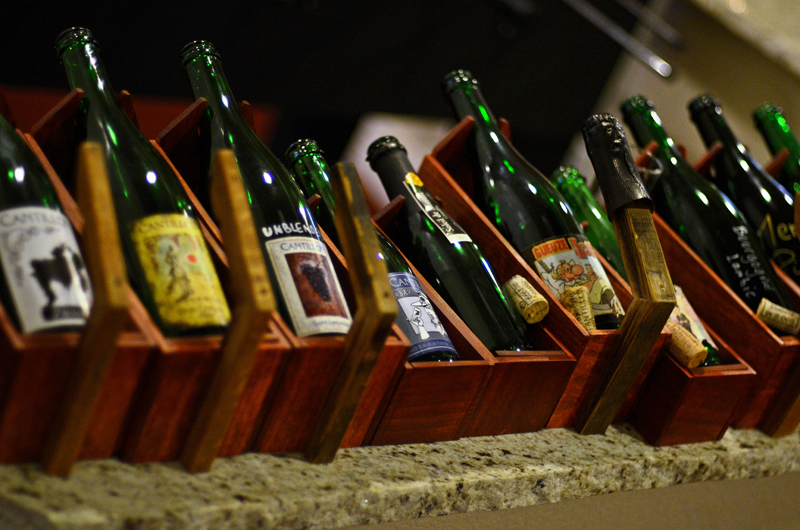Tasting Ghost Whales
Vintage Collectors Gather to Drink Legendary Beers

A collection of rare beers at a tasting at collector Bill Young’s house in 2013. Photo by Lindsay Dawson.
They called it the Ghost Whale tasting. A gathering of the world’s foremost beer hunters. It was to be the tasting to end all tastings, the one that all others are judged against. Big words, big statements, but these guys had what it took to put it together: deep pockets, strong connections and an almost maniacal obsession with hunting rare beers.
Exceptionally rare beers have been nicknamed “Whales” (the whole, “biggest creature in the sea” thing), and the most exclusive of these whales are referred to as “White Whales.” Beers such as Rodenbach’s cherry-infused Alexander Rodenbach (last made in 2000) or Drie Fonteinen’s Millennium Geuze (one-off, limited Belgian distribution). But narrow this group down even further to the most elite of the white whales and you’ve got “Ghost Whales” (the moniker for the white beluga). For a beer to be deemed a ghost whale, it must not only come from a deeply respected producer, but also have a scarcity that limits remaining bottles to numbers you learned to count to in kindergarten. These extraordinary near-extinct beers, such as the original ’03 batch of Cantillon’s cloudberry masterpiece, Soleil de Minuit, or Lost Abbey’s for-friends-only Veritas 005, can fetch over $4,000 apiece among private collectors.
The idea for this super-tasting started when a Denver beer collector, Bill Young, got his hands on a bottle of Driesjes Eerste Plasje. (Don’t feel bad if you’ve never heard of this beer; you’re not alone. It’s so rare most hard-core beer geeks have never heard of it.) Translated from Dutch to “Boy’s First Pee,” multiple rumors have swirled regarding the origin of this beer, including that it was the first batch that Armand DeBelder, Drie Fonteinen’s famed blender ever produced. In reality, it was a batch of custom-labeled 1998 Drie Fonteinen gueuze, handed out to family and friends by long-time Antwerp lambic aficionado Hans Bombeke to celebrate the birth of his twins. As the twins were a fraternal boy-girl set, a batch of custom-labeled Oud Beersel Kriek was also issued, called Myrthes Eerste Plasje (Girl’s First Pee).
Drie Fonteinen has never publicly acknowledged that the gueuze even exists, but legend goes that only 28 bottles were ever made, given solely to family and friends, and the rest of the batch was served on draft. The debut beer to come from what many will argue is the world’s greatest lambic blender is obviously something very special. Just imagine coming across Picasso’s first commissioned work or discovering an original copy of Beethoven’s Symphony No. 1.
Young traded for the bottle with a Belgian connection he’d developed during his work travels as a global computer security consultant (think Robert Redford in the movie “Sneakers”). Combining his travels, a love of rare beer and a global computer security consultant’s salary, he’s been able to develop relationships with various European beer collectors who have hoards of whales in their cellars. Collectors who are willing to part with particular bottles for the right offer.
After scoring the bottle, though, Young had a question: When exactly does one drink such a rarity?
“This beer was so extremely rare I didn’t just want to pop it at a normal tasting. I wanted to share it with people who’d really appreciate it,” Young says. “Then I had an idea. I realized that there were still a handful of remaining ghost whales out there that I wanted to try, but had never seen. That’s when I came up with the idea for this tasting, by offering up to share the Driesjes Eerste Plasje, I could possibly bring some of these other rare beers out of hiding.”

Bill Young finds rare beers through connections with European beer collectors. Photo by Lindsay Dawson.
To sweeten the deal, Young threw in another ghost whale, a 1.5-liter magnum of Cantillon’s 1991 De Dolle Kersengueuze (more on that later) and sent feelers out to several of the world’s foremost whale hunters. The rules were simple. First, each attendee had to bring one ghost whale and one white whale. Second, each beer’s “whale status” had to be agreed upon via unanimous group vote. Third, beers brought had to be lambic or gueuze. (While there are certainly barley wines and other styles that can be considered ghost whales, Young, a self-proclaimed “lambic head,” wanted to focus on his favorite style.) With the formalities settled and invitations accepted, the date was set for a lengthy 18 months out, and the world’s finest beer hunters began stalking their prey.
Patrick Dawson
Patrick Dawson is the author of Vintage Beer, a book that explores the cellaring of beer. When not at home in Denver, he’s traveling the globe in search of new and exciting brews to add to his cellar.

What was the cost to attend this event? Beyond the bottle(s) people brought, of course…